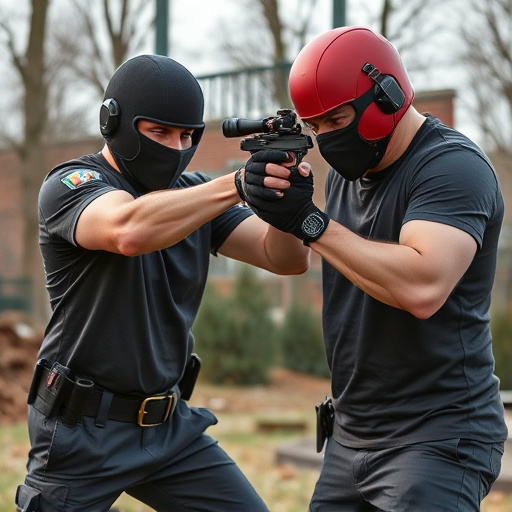Pepper Spray Training for Beginners emphasizes understanding spray operation, aiming, de-escalation, and local laws. Proper training ensures accurate targeting, minimizes harm to non-aggressors, and maximizes effectiveness while adhering to legal rules on usage. Choosing the right dispenser, safe storage, and regular practice are crucial. Debriefings post-training cover components, risks, incident reporting protocols, and refresher courses maintain proficiency.
“Uncover the power of pepper spray as a riot control tool with our comprehensive guide. For beginners, ‘Understanding Pepper Spray: Basics for Beginners’ provides essential insights into its mechanisms and effects. Navigate legal considerations and learn usage guidelines in ‘Legal Considerations and Usage Guidelines’.
In ‘Choosing the Right Riot Control Spray Dispenser’, we explore factors for effective selection. Master training techniques and safety protocols in ‘Effective Pepper Spray Training Techniques’ and ‘Safety Measures and Post-Training Protocols’ to ensure responsible use. Discover the steps towards becoming proficient in pepper spray training for beginners.”
- Understanding Pepper Spray: Basics for Beginners
- Legal Considerations and Usage Guidelines
- Choosing the Right Riot Control Spray Dispenser
- Effective Pepper Spray Training Techniques
- Safety Measures and Post-Training Protocols
Understanding Pepper Spray: Basics for Beginners
Pepper spray, a powerful tool in riot control and self-defense, is a substance that disrupts vision, breathing, and movement when sprayed directly onto an individual’s face or eyes. It’s crucial for beginners to understand the basics of pepper spray to effectively utilize it during training sessions and real-life situations.
For starters, learning how to properly operate the spray dispenser is essential. This includes understanding the trigger mechanism, aiming techniques, and the safe distance at which to deploy the spray. Pepper spray training for beginners should also cover de-escalation tactics; knowing when and how to use pepper spray can prevent further aggression and ensure user safety. Familiarity with local laws and regulations regarding its usage is equally important to avoid legal repercussions.
Legal Considerations and Usage Guidelines
The legal considerations surrounding inflammatory riot control spray, often referred to as pepper spray, are crucial and vary significantly across jurisdictions. Before deploying such devices, it’s essential for individuals, especially those considering Pepper Spray Training for Beginners, to understand the local laws and guidelines. Each region has specific rules dictating when and how these sprays can be used by both law enforcement and civilians.
Usage guidelines emphasize proportionality and necessity. Pepper spray should only be employed as a last resort when other de-escalation tactics have failed. Proper training is vital; it ensures users can accurately target, minimizing harm to bystanders and maximizing the impact on intended aggressors. Understanding these nuances is key to responsible usage, ensuring compliance with the law, and maintaining public safety during potentially volatile situations.
Choosing the Right Riot Control Spray Dispenser
Choosing the right riot control spray dispenser is crucial, especially for those engaging in Pepper Spray Training for Beginners. The first step is understanding your specific needs and the type of riots or disturbances you’re preparing for. Different dispensers have varying range, strength, and features; each designed to tackle distinct scenarios. For instance, shorter-range sprays are suitable for close-quarter control while longer-reach options are better suited for dispersing large crowds.
Additionally, consider factors like ease of use, reliability in adverse conditions, and the type of pepper spray formulation. Beginners should opt for user-friendly models with clear instructions, ensuring safety during deployment. It’s also essential to incorporate regular practice sessions with the chosen dispenser, allowing users to become comfortable and proficient in its application, particularly in high-pressure situations.
Effective Pepper Spray Training Techniques
For those new to pepper spray, proper training is essential. Starting with basic understanding and handling techniques is crucial. Begin by learning safe storage practices and familiarizing yourself with the dispenser’s mechanics. Practice aim and range, ensuring a firm grip and comfortable position for optimal control.
Next, focus on targeted application. Train in various scenarios, like crowd control or self-defense, to develop precision. Learn about de-escalation techniques and when to use pepper spray as a last resort. Regular sessions with experienced instructors can help beginners master these skills, ensuring they remain calm under pressure and effectively deploy the spray when needed.
Safety Measures and Post-Training Protocols
After learning about and handling a pepper spray dispenser during beginner training, it’s paramount to prioritize safety measures. Proper debriefing sessions post-training are crucial for all participants. These discussions should focus on understanding the spray’s active ingredients, their potential health impacts, and safe storage practices to avoid accidental exposure.
Following training, establishing clear protocols for incident reporting and medical assistance is essential. Beginners should be familiar with emergency contact details, de-escalation techniques learned during training, and when to use pepper spray as a last resort. Regular refresher courses can ensure that everyone remains proficient and adheres to the highest safety standards.
Pepper spray, a powerful tool in riot control, requires careful handling and responsible usage. As this article has guided beginners through its basics, legal aspects, and training techniques, it’s crucial to emphasize continuous learning and adherence to safety protocols. Choosing the right dispenser and staying informed about local regulations are key steps in ensuring effective Pepper Spray Training for Beginners while maintaining public safety. Regular practice sessions and post-training reviews will help individuals respond calmly and effectively in real-world scenarios.
